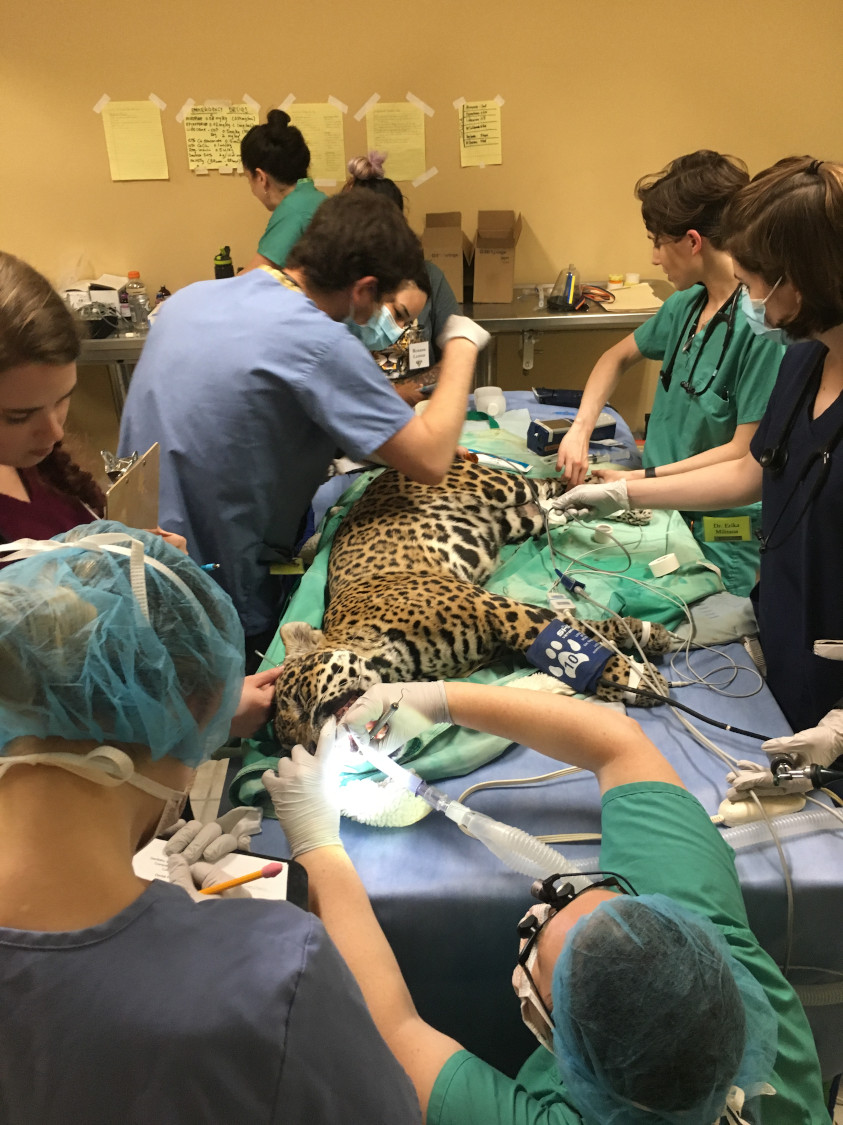Interdisciplinary Cornell Team Publishes Findings on Dental Diseases in Captive Jaguars in Belize
Research analyzing the prevalence of dental diseases in captive jaguars in Belize was recently published by Lindsey Schneider, DVM ’13, and a team of veterinary colleagues in the Journal of Zoo and Wildlife Medicine. Dr. Schneider completed the research during her residency in Dentistry and Oral Surgery at the Cornell University College of Veterinary Medicine (CVM).
Since 2003, a team of clinicians, technicians, and students from CVM has traveled to Belize to provide veterinary care at the Belize Zoo and Tropical Education Center. The Belize Zoo was founded in 1983 with goals of education and conservation, and now houses over 175 animals of 48 species, all native to the region, and many that are threatened or endangered.
As part of its conservation mission, the Belize Zoo has a program to house jaguars that are brought into captivity because they preyed on livestock. Evaluations to date indicate that older, injured, or sick animals are more likely to become problem predators. Dental examinations of the zoo’s five wild cat species are an important part of the routine medical and surgical assessments of these animals, and of course require anesthesia.
The team reviewed dental records and characterized the prevalence of dental diseases in 15 captive jaguars over a four-year period. The overall rate of periodontal disease was lower in jaguars than in pet domestic cats, thought to be partly due to the texture of the diet, which included bones. The study also reported tooth fractures (73.3%), retained tooth roots (50%), and dental abrasions (80%), as well as tooth resorption (13.3%), which had not been previously documented in jaguars. Half of the jaguars with dental abrasions showed a pattern consistent with cage-biting behavior (some of which might have happened at the time of capture and transport into captivity). The study also found that root canal treatments had a higher rate of failure in jaguars than in domestic dogs and cats.
This research has implications for recommendations on diet, housing, behavioral enrichment, and clinical care for captive jaguars. In addition, dental care in large cats is often pursued once a clinical problem is noticed – such as difficulty eating or a visibly abnormal tooth. However, annual dental examinations, as recommended for domestic cats, could result in earlier detection or prevention of dental diseases. As a result, the Cornell veterinary team has transitioned to performing yearly examinations for every jaguar at the Belize Zoo.
“Our work at the Belize Zoo was the highlight of my residency: I have always been passionate about wildlife, so it was very rewarding to extrapolate the skills I was learning on domestic species at CUHA [Cornell University Hospital for Animals] to treat endangered species,” said Schneider. “The experience not only taught me about working in field conditions, but also helped me hone a holistic clinical approach. In a zoo setting, treatment decisions must take into account not only the patient’s pathology, but also their environment, diet, natural vs. captive behaviors, and the follow-up that can be provided for the animal. It is my hope that this publication will increase awareness about the prevalence of dental diseases in captive felids, as well as encourage those responsible for their care to collaborate with veterinary dentists and oral surgeons to provide treatment.”
Dr. Schneider completed her residency at Cornell and is now practicing in the state of Washington, where she hopes to eventually expand into outreach at zoo and wildlife sanctuaries to provide dental care for captive wildlife.
Since 2017, the Belize trips have been funded by a generous grant from the John T. and Jane A. Wiederhold Foundation. The trip allows veterinary students to develop clinical skills with non-domestic species through a multidisciplinary approach involving anesthesia and dentistry experts, expand their international experience, and earn credit through the International Experience in Wildlife Health and Conservation course.
Isabel Jimenez, DVM ’19, second author on the publication, traveled to the Belize Zoo as a third-year veterinary student. During the same trip, Jimenez also identified the first case of Lynxacarus mite infestation in a jaguar, resulting in another publication.
Written by Isabel Jimenez, DVM ‘19

